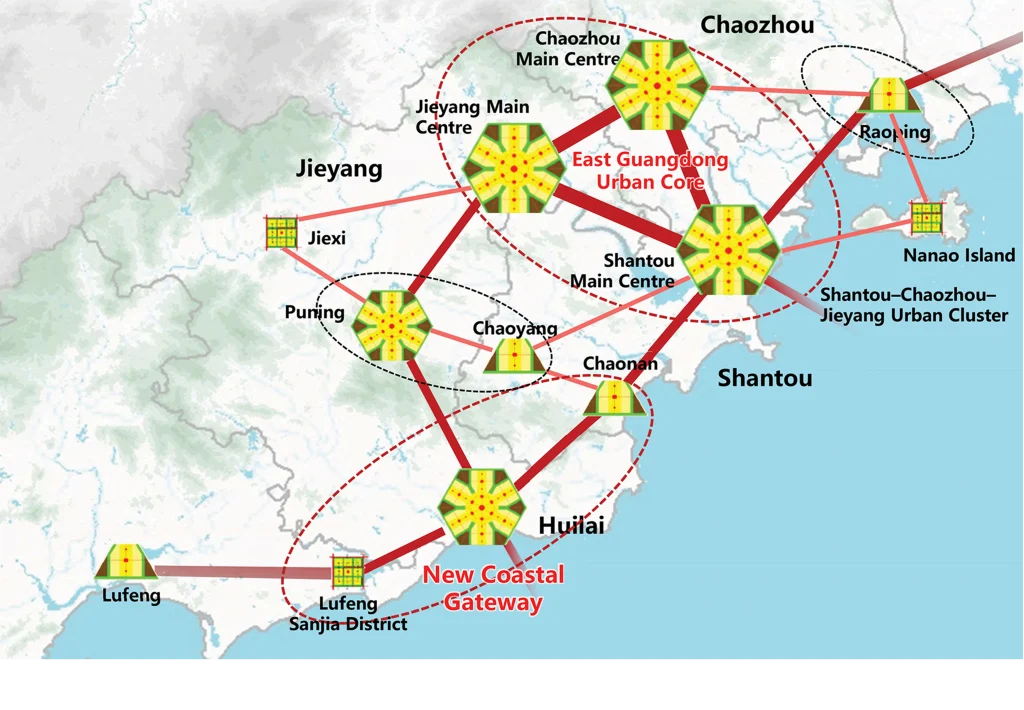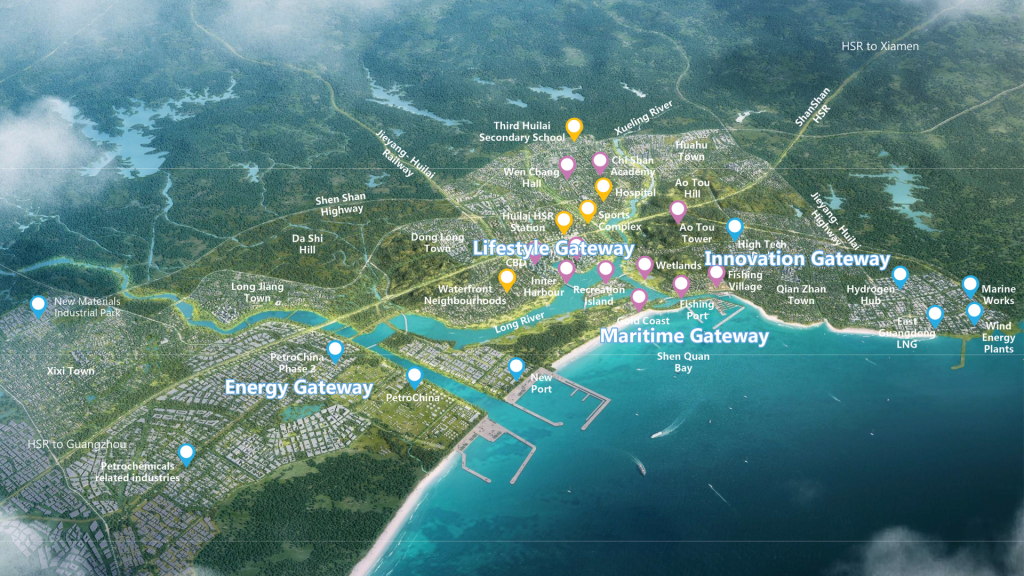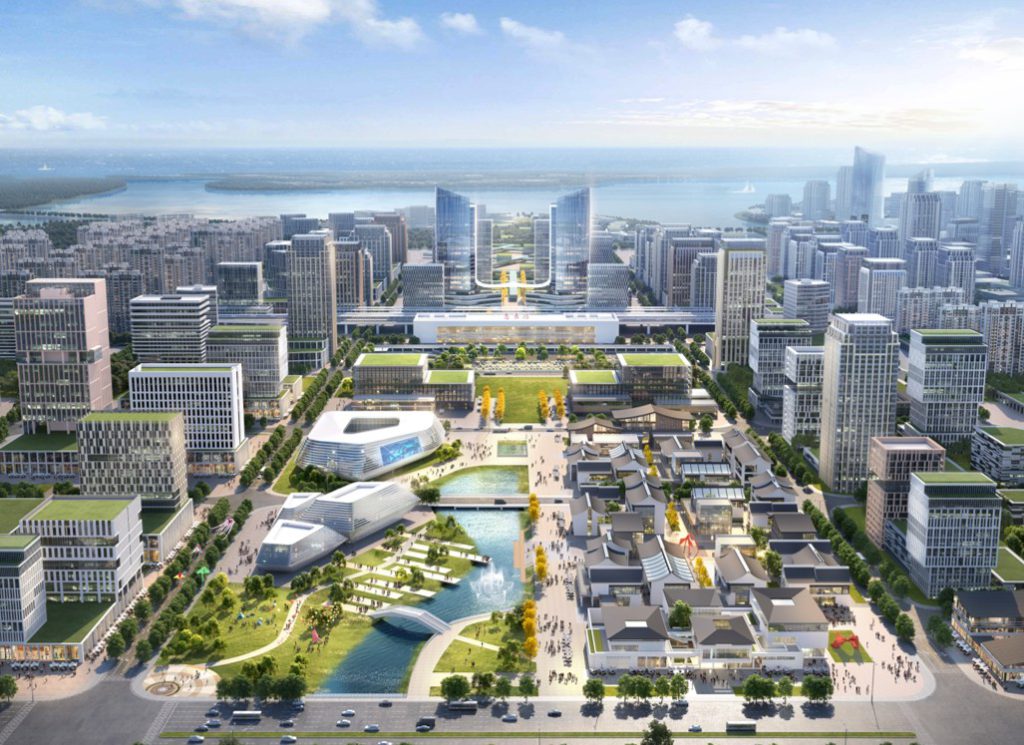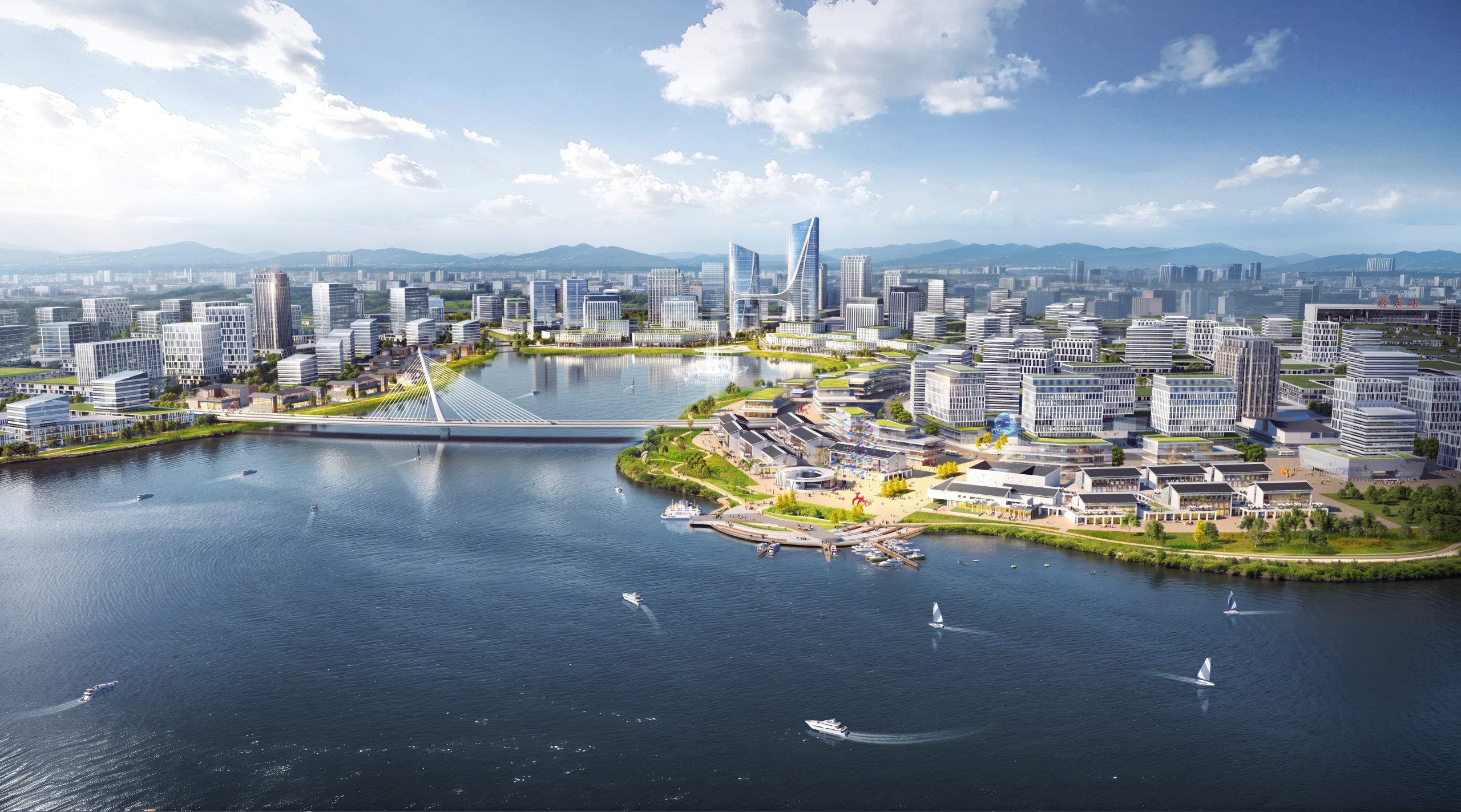Client:
Jieyang Planning Bureau
Project Type:
City
Site Area:
260 km²
Completion:
July 2024
Redefining Coastal Urbanism in Eastern Guangdong
The Jieyang City Strategic Masterplan & Huilai County Concept Plan and Urban Design set a bold new benchmark for coastal development in Eastern Guangdong. Traditionally inward-facing, Huilai is reimagined as a future-ready coastal hub, integrated into both regional and national growth strategies.
At the heart of the plan is a dual-orientation strategy. Instead of looking solely westward toward the Pearl River Delta, Jieyang pivots east to connect with Fujian Province. This repositions Jieyang as a central player in regional connectivity, rather than a peripheral city. The “constellation city” model links Jieyang, Shantou, Chaozhou, and Huilai through shared infrastructure, coordinated economic clustering, and ecological integration – unlocking a new pathway for balanced regional growth.

Within Huilai, four anchor gateways – Lifestyle, Maritime, Energy, and Innovation – catalyse investment, diversify the economy, and enhance coastal identity. This framework not only drives sector-specific growth but also fosters social inclusion and resilience.

A Holistic, Values-Driven Approach
The masterplan is built on MORROW’s rigorous, multi-scalar methodology, informed by six lenses: economy, ecology, infrastructure, transport, maritime, and culture. Rather than treating these as isolated components, the plan weaves them into a unified framework extending from regional strategy to neighbourhood design.
Key highlights include:
Resilient Accessibility: Compact urban design ensures that daily needs are met within a 15–30 minutes’ commute, while high-speed rail places Huilai around one hour of Xiamen and Guangzhou.
Ecological Corridors as Infrastructure: Green and blue networks connect hills to sea, regulating climate, reducing flood risks, sustaining biodiversity, and enhancing public space.
Cultural Continuity: Lingnan traditions (i.e. shaded arcades, courtyards, and alleyways) are reinterpreted in a contemporary form, creating an identity-rich and climate-responsive urban fabric.
Together, these strategies form more than a physical blueprint; they set the foundation for a resilient, connected, and culturally distinctive city. By aligning long-term vision with tangible interventions, the plan charts a clear path for Huilai to grow as a sustainable and liveable modern coastal city.
At every layer, the values of equity, sustainability, and cultural identity shape decisions. Equity ensures inclusivity and fairness in access to opportunities, sustainability embeds long-term resilience and ecological balance, and cultural identity safeguards the continuity of heritage so that growth is not only efficient, but also inclusive, resilient, and deeply rooted in place.
This ensures that development transcends short-term gains, creating a city that endures, adapts, and remains meaningful to its people across generations.
Core Values in Action
Equity: A decentralised framework distributes schools, healthcare, jobs, and amenities across functional clusters, reducing commute times and broadening access to opportunity.
Sustainability: Nature is embedded at the heart of the city. Rivers, wetlands, and coastlines are preserved as multifunctional green-blue corridors, supporting biodiversity, stormwater management, and recreation.
Economic Vitality: Flexible zoning supports both stable and emerging industries, from marine and clean energy to tourism and innovation. Phased development ensures infrastructure readiness and investment confidence.
Cultural Identity: The plan protects the heritage form of Huilai Old Town while embedding Lingnan architectural language into new growth areas, ensuring continuity between past and future.
From Vision to Implementation
A defining strength of the plan lies in its implementability. Far from a conceptual exercise, it is grounded in clear governance structures, phased delivery mechanisms, and strong policy alignment at both the municipal and regional levels. Its feasibility is further underpinned by over RMB 20 billion in government investments, earmarked for infrastructure, ecological restoration, and cultural renewal. This ensures that the masterplan is not only visionary in scope but also actionable in practice, with the financial and institutional capacity to translate ideas into tangible outcomes.
Policy Support: Approved by Jieyang City, and supported by Guangdong Province, the plan serves as a statutory reference for land use, zoning, and infrastructure.
Catalytic Zones: Seven priority zones, including a new downtown, high-speed rail district, and innovation park, have been earmarked for early development to drive momentum.
Phased Delivery: Modular growth clusters allow flexibility, balancing ambition with feasibility and ensuring adaptability to demographic and market shifts.
Green Infrastructure: Nature-based solutions such as sponge city systems and wetland parks are embedded as structural elements, not add-ons.
Major anchor projects, from offshore wind farms to maritime logistics hubs, are already underway, reinforcing the city’s role as a regional energy and logistics centre while advancing decarbonisation goals.
A Living Framework for the Future

Together, these strategies transform Jieyang–Huilai into a model of coastal urbanism: one that balances ecology, economy, and culture to build a city that is liveable, resilient, and competitive on both regional and global stages.
By anchoring long-term foresight with practical implementation, the masterplan not only charts a new future for Jieyang but also offers a replicable model for other rapidly urbanising coastal regions in China and beyond.


